Mercury Deposition
Mercury Deposition Network Monitoring at VT99
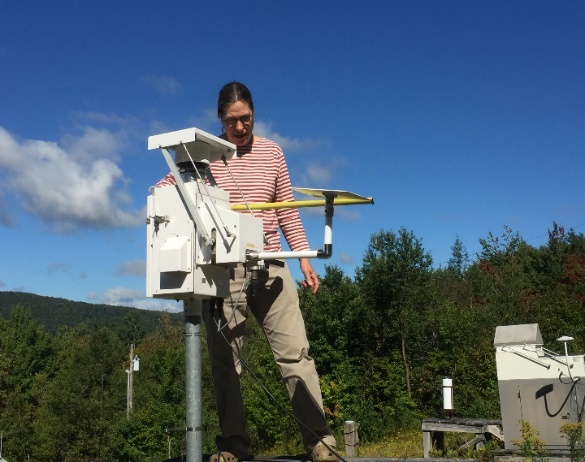
Mercury is a persistent pollutant that can accumulate in organisms as it moves up the food chain, leading to neurological damage, lowered reproductive success, motor skill impairment and hormonal changes in humans and animals (Driscoll et al., 2007, Evers et al., 2004). Human activities such as fossil fuel burning and waste incineration elevate levels of atmospheric mercury, which is later transferred to forests and water bodies through both dry and wet (in precipitation) deposition. Since 1992, VMC has been collecting data on both wet and dry mercury deposition, making it one of the longest records in the U.S. In 2004, the VMC joined the Mercury Deposition Network (MDN, part of the National Atmospheric Deposition Program) as one of over 120 sites in the U.S. and Canada. The VMC air quality site serves as a sentinel site for the northeastern U.S. – it is high enough in elevation to detect regional mercury transport events that are not detected by other stations. This very long record has provided context to many shorter-duration studies, including the way mercury cycles through the forest canopy1, how mercury bioaccumulates in birds2 and amphibians3, how mercury levels are influenced by elevation4, and how falling leaves contribute to deposition5. VMC and its partners have committed to this long-term monitoring in order to document and better understand the input of mercury into Vermont’s forested ecosystems and the inhabitants of those ecosystems, including birds, fish, bobcats and human beings.
The Data
VMC conducts year-round sampling of precipitation chemistry at the air quality monitoring site at the Proctor Maple Research Center in Underhill, Vermont. Weekly composites of precipitation are gathered in an automated wet-only precipitation collector at the site. The collector opens automatically when rain or snow is detected, capturing precipitation through a funnel and tube sampling train into a bottle charged with hydrochloric acid (to preserve the sample). The collector is heated in the winter and vented in the summer as needed. Samples are collected every Tuesday and shipped to the Mercury Analytical Laboratory at Eurofins Frontier Global Science, Inc. in Bothell, WA for analysis of mercury concentration and cleaning of the sampling train. Data are submitted to NADP for quality control and posted on the NADP/MDN website (http://nadp.isws.illinois.edu/data/MDN/).
2015 in Summary
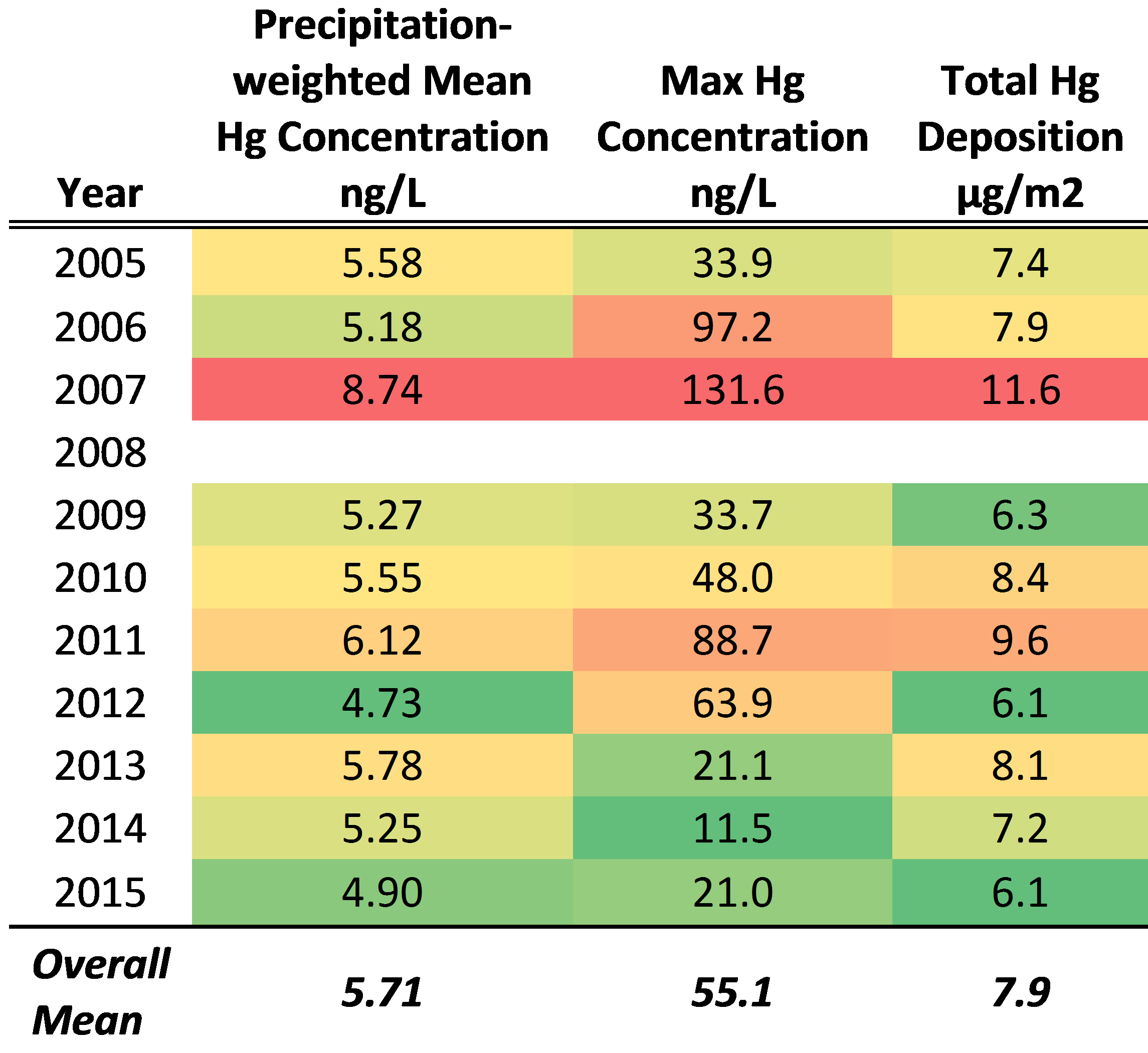
Mercury monitoring at VMC’s air quality site (VT99) for 2015 shows lower deposition than on average for the 11-year record, being equal to 2012 and slightly lower than 2009, which makes 2015 one of the lowest years on record (Table 4). Over the entire record for VT99, total mercury deposition fluctuated from a high of 11.6 µg/m2 in 2007 to a low of 6.1 µg/m2 in 2012 and 2015. Similarly, the precipitation-weighted mean mercury concentration and the maximum mercury concentrations measured at VT99 are quite variable, and for 2015 both were below the mean for the entire record. Across the United States, Vermont registered lower concentration and deposition averages that most other sites (Figure 13).
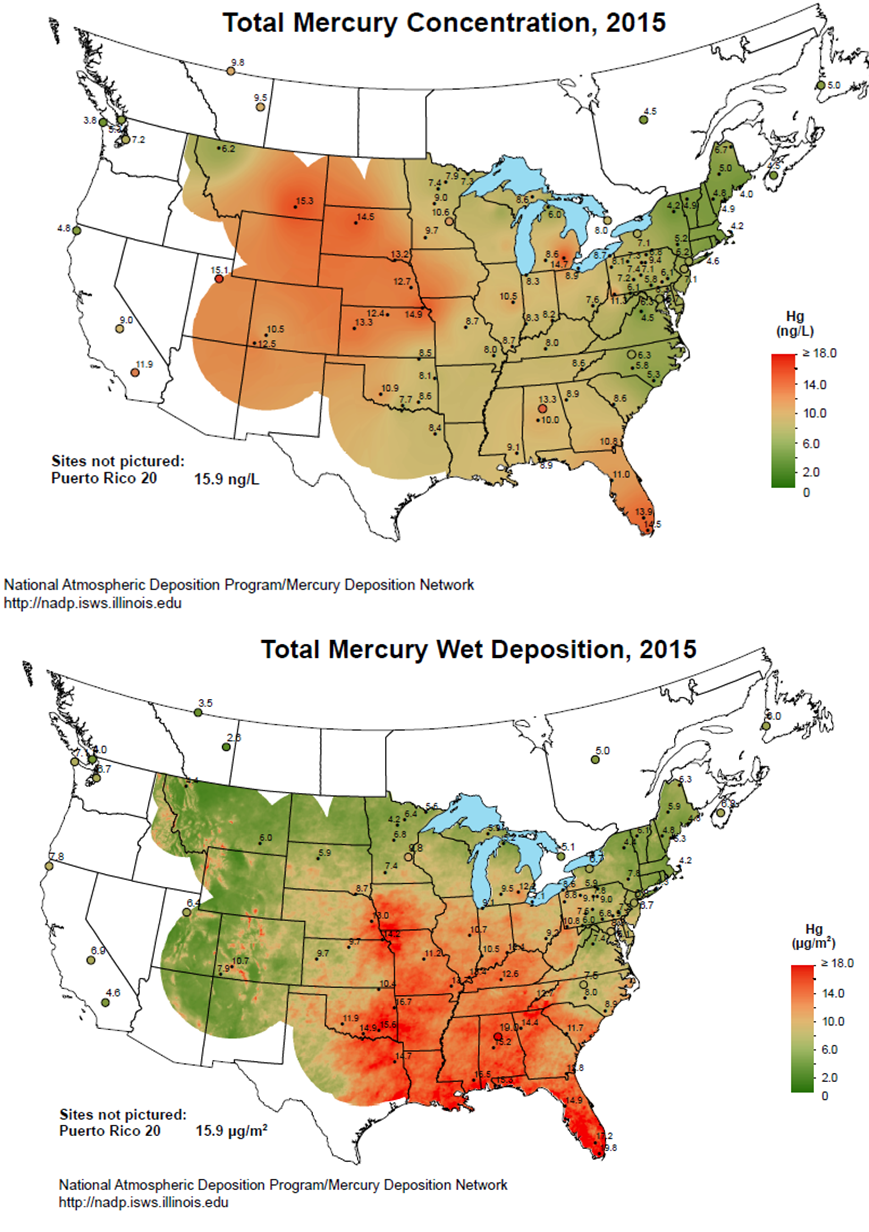
Long Term Trends
Over 10 years of monitoring at VT99, mean annual deposition is higher than 41% of national MDN sites. Thus 2015 was a relatively good year for VT99, with only roughly a quarter of national MDN sites recording lower mean deposition. Mercury deposition has decreased in VT in recent years, but still remains among the highest deposition rates in the region (Figure 14).
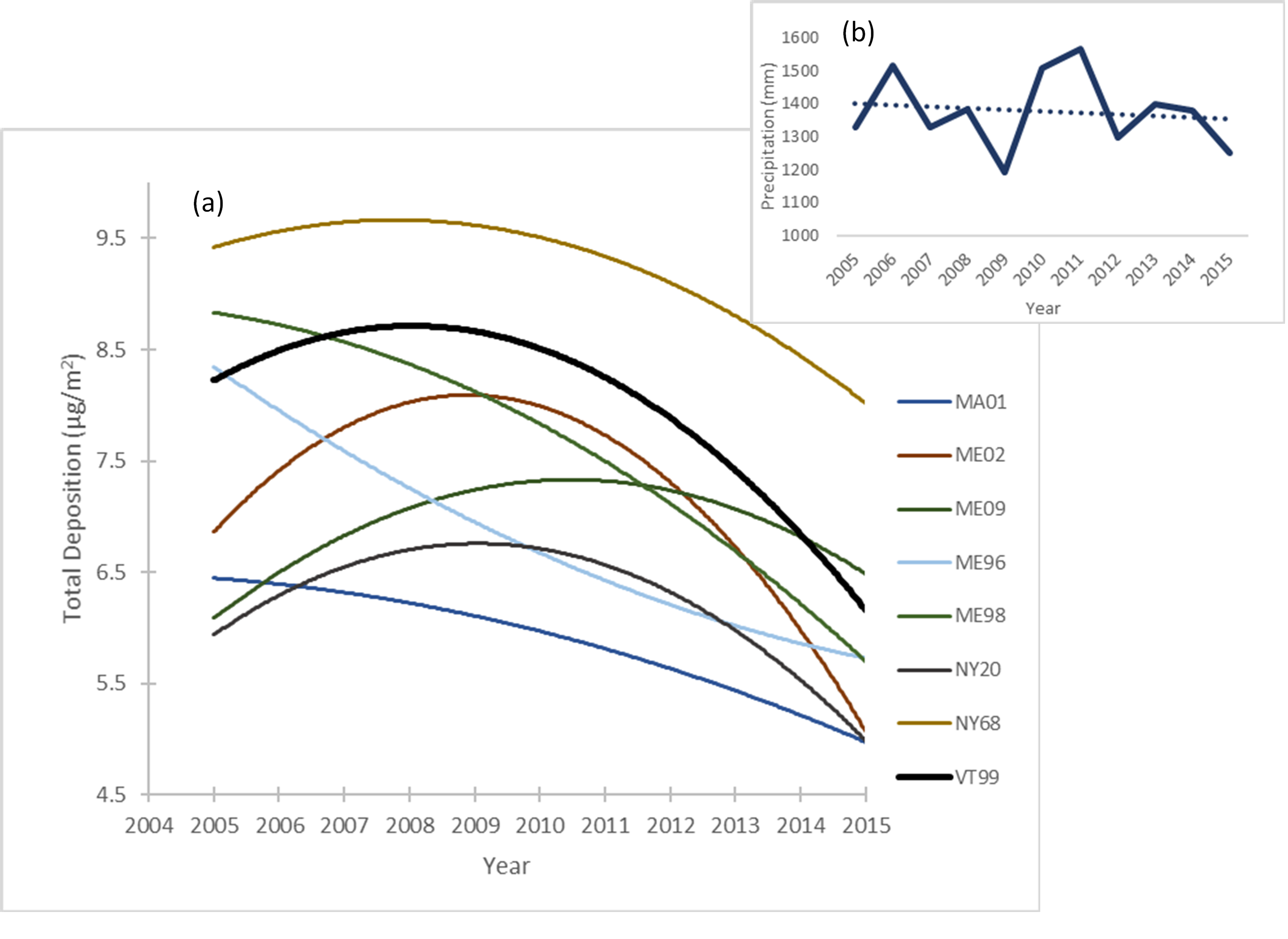
Indeed, a recent regional trends analysis using NADP MDN data (Figure 2) provides further signs of regional differences for VT99 (NADP 2015). Different time periods were analyzed, including the entire record 1997-2013, and then several shorter portions of the record. As the MDN network was expanding the shorter time period analyses were a way to incorporate the changing spatial pattern into the trends analysis. This period from 2008 to 2013 shows VT99 having a statistically significant positive slope in increased mercury concentrations. Five years is too short for a definitive trend but might suggest, due to its relatively high altitude and the absence of nearby coal utility boilers, that VT99 is more influenced by global sources than are surrounding lower altitude MDN sites (Weiss-Penzias et al., 2016).
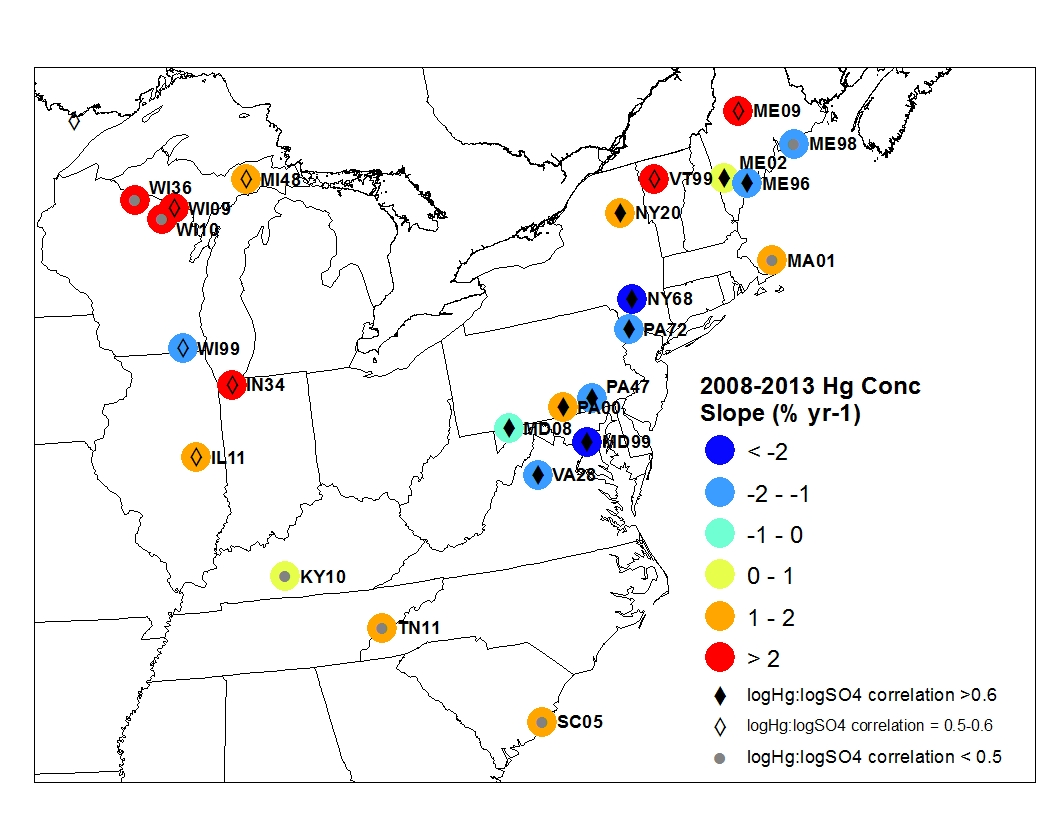
For a larger perspective, compared to the national network of MDN sites (Table 2), deposition at the VT99 monitoring station has ranged from the high end (85th percentile in 2007) to the low end (14th percentile in 2012) of measured values within the network. Over the period from 2005 to 2015, the VT99 site is in the 41st percentile for reported mercury deposition values across the Mercury Deposition Network.

Implications
Mercury deposition levels have decreased dramatically with the enactment of clean air legislation in the late 20th century (Kamman and Engstrom, 2002). The atmosphere is the main pathway for mercury into Vermont’s ecosystems, and it is estimated that more than half of this atmospheric deposition comes from dry deposition. While NADP is committed to increasing monitoring of dry mercury deposition, VMC unfortunately had to terminate its Atmospheric Mercury Network site on Dec. 31, 2015, so future dry deposition rates will have to be inferred rather than measured.
Mercury persists in the environment, cycling through various storage pools. The continued low-level input and occasional spikes will likely drive cumulative increases in mercury in Vermont’s forests, which are particularly sensitive to these inputs (Driscoll et al., 2007; Gay personal communication, 2016; Weiss-Penzias et al., 2016). Fish mercury burdens are one way to track these trends and in Vermont, fish advisories are still being issued (Chalmers et al., 2014; Vijayaraghavan et al., 2014). Until fish tissue sampling shows a long-term negative trend, the need to monitor mercury is critical.
Historically, sulfate emissions have been strongly correlated with mercury emissions because they shared the same primary source, coal-fired utility boilers, but with the impressive reduction in sulfates mandated by the Clean Air Act, this is no longer true. In the northeast, mercury concentrations are up, suggesting that mercury measured here is not associated with regional sulfur emissions. The Environmental Protection Agency’s Mercury and Air Toxics Standards (“MATS”), which will implement emissions reductions of toxic air pollutants from existing and new coal and oil-fired power plants, has continue to progress. If it stays in place, we could see a downward trend in mercury deposition from regional sources in Vermont and the Northeast in the coming years.
More emission to the atmosphere from the globally occurring pollutant mercury could mean more deposition for everyone - higher concentrations in fish leading to higher concentrations in humans. This underscores the need to monitor and curtail anthropogenic contributions of mercury in Vermont and worldwide.

Regionally, Vermont’s precipitation-borne mercury has not been decreasing as quickly as in neighboring states, highlighting the role of Vermont in monitoring and identifying global patterns of mercury pollution.
References
- Chalmers, A.T., Krabbenhoft, D.P., Van Metre, P.C. and Nilles, M.A., 2014. Effects of urbanization on mercury deposition and accumulation in New England. Environmental Pollution, 192, pp.104-112.
- Driscoll, C. T., Han, Y. J., Chen, C. Y., Evers, D. C., Lambert, K. F., Holsen, T. M., and R.K. Munson. (2007). Mercury contamination in forest and freshwater ecosystems in the Northeastern United States. Bioscience, 57(1), 17-28. doi: 10.1641/b570106.
- Gay, D. 2016. Pers comm.
- Evers, D.C., Lane, O.P., Savoy, L. and W. Goodale. 2004. Assessing the Impacts of Methylmercury on Piscivorous Wildlife Using a Wildlife Criterion Value Based on the Common Loon, 1998–2003. Gorham (ME): Maine Department of Environmental Protection, BioDiversity Research Institute. Report no. BRI 2004-05.
- Kamman, N.C., and D.R. Engstrom. 2002.Historical and present fluxes of mercury to Vermont and New Hampshire lakes inferred from 210Pb dated sediment cores. Atmospheric Environment 36: 1599–1609.
- National Atmospheric Deposition Program (NADP). 2015. National Atmospheric Deposition Program 2014 Annual Summary. NADP Data Report 2015-01. Illinois State Water Survey, University of Illinois at Urbana-Champaign, IL.
- Vijayaraghavan, K., Levin, L., Parker, L., Yarwood, G. and Streets, D., 2014. Response of fish tissue mercury in a freshwater lake to local, regional, and global changes in mercury emissions. Environmental toxicology and chemistry, 33(6), pp.1238-1247.
- Weiss-Penzias, P.S., Gay, D.A., Brigham, M.E., Parsons, M.T., Gustin, M.S. and ter Schure, A., 2016. Trends in mercury wet deposition and mercury air concentrations across the US and Canada. Science of The Total Environment. Available online at http://dx.doi.org/10.1016/j.scitotenv.2016.01.061
Additional Resources
- Vermont Health Department Fish Consumption Recommendations: http://healthvermont.gov/enviro/fish_alert/documents/fish_alert.pdf
- Global Sources of Local Pollution: An Assessment of Long-Range Transport of Key Air Pollutants to and from the United States. 2009. National Academy of Sciences. Chapter 4, Mercury: Atmospheric Mercury Primer. https://www.nap.edu/read/12743/chapter/6#99
VMC Project Database Link
- Wet Deposition of Mercury at Proctor Maple Research Center (Mercury Deposition Network-MDN) https://www.uvm.edu/femc/project/wet-deposition-mercury-proctor-maple-research
Footnotes
- 1Mercury Flux at PMRC - https://www.uvm.edu/femc/project/mercury-flux-pmrc
- 2Bicknell's Thrush Population Demographics and Ecology: Assessing levels of methylmercury in montane forest bird community on Mount Mansfield - https://www.uvm.edu/femc/project/bicknells-thrush-population-demographics-ecology-assessing
- 3Mercury Burdens in Amphibians - https://www.uvm.edu/femc/project/mercury-burdens-amphibians
- 4Cloudwater Chemistry on Mount Mansfield - https://www.uvm.edu/femc/project/cloudwater-chemistry-mount-mansfield
- 5Litterfall Mercury Dry Deposition in the Eastern USA - https://www.uvm.edu/femc/project/litterfall-mercury-dry-deposition-eastern-usa
